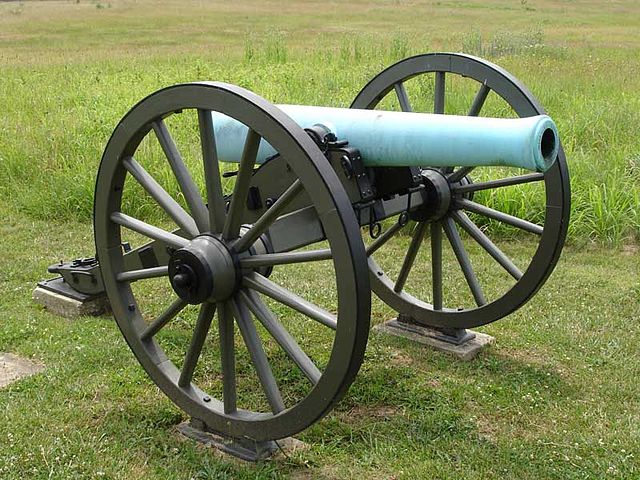1st Minnesota Infantry Regiment
The 1st Minnesota Infantry Regiment was a Union infantry regiment active during the American Civil War. The 1st Minnesota participated in the battles of First Bull Run, Antietam and the Battle of Gettysburg. The regiment's most famous action occurred on the second day of the Battle of Gettysburg when Major General Winfield Scott Hancock ordered the 1st Minnesota to charge into a brigade of 1200 Confederate soldiers. This action blunted the Confederate attack and helped preserve the Union's precarious position on Cemetery Ridge.

The Regimental Banner of the 1st Minnesota Volunteer Infantry Regiment consists of one layer of blue silk with a gold fringe border and the unofficial Minnesota state seal painted in the center with the Minnesota State Motto over it in gold pigment. Beneath the seal is a painted red ribbon reading "FIRST MINNESOTA VOLUNTEERS." Two gold shields list the battles fought by the 1st Minnesota before April of 1863. The Regimental Banner should not be confused with the Regiment’s Battle Flag, which was the U.S. flag with the letters "M" and "N" sewn in gold fabric across the stripes. It should also not be confused with the Flag of Minnesota which did not have its first version adopted until 1883 and was later revised on three other occasions.
Image of Colonel Colvill when he was still a Captain.
Plain brass First Minnesota Volunteer Infantry badge worn on the kepi. It was worn by Sergeant Chesley Billings Tirrell of Company C. The officers version was nickel plated. The trefoil was the Corps emblem of the II Corps that the 1st Minn. was attached to.Minnesota Historical Society.
Monument to the 1st Minnesota Infantry Regiment at Gettysburg Battlefield, Gettysburg, Pennsylvania, located on Cemetery Ridge, off South Hancock Avenue.
The Battle of Gettysburg was a three-day battle in the American Civil War fought between Union and Confederate forces between July 1 and July 3, 1863, in and around Gettysburg, Pennsylvania. The battle, which was won by the Union, is widely considered the Civil War's turning point, ending the Confederacy's aspirations to establish an independent nation. It was the Civil War's bloodiest battle, claiming over 50,000 combined casualties over three days.
The Battle of Gettysburg by Thure de Thulstrup
M1857 12-Pounder "Napoleon" at Gettysburg National Military Park Gettysburg, Pennsylvania, September 2006
This November 1862 Harper's Magazine illustration shows Confederate Army troops escorting captured African American civilians south into slavery. En route to Gettysburg, the Army of Northern Virginia kidnapped between 40 and nearly 60 Black civilians and sent them south into slavery.
Union Army breastworks on Culp's Hill, 1863








